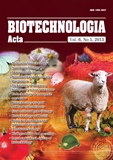ISSN 2410-776X (Online),
ISSN 2410-7751 (Print)

"Biotechnologia Acta" v. 6, no. 5, 2013
https://doi.org/10.15407/biotech6.05.115
Р.115-121, Bibliography 25, Russian
Universal Decimal classification: 591.471+611.018.2/6:57.086.8
О. Yu. Rogulska1, О. B. Revenko1, Yu. O. Petrenko1, H. Ehrlich2, О. Yu. Petrenko1
1Institute for problems of Cryobiology and Cryomedicine of National Academy of Sciences of Ukraine, Kharkiv, Ukraine
2Institute of Experimental Physics, TU Bergakademie Freiberg, Freiberg, Germany
Development of the new types of tissue engineered structures is one of the promising trends of current biotechnology. The study was directed to the assessment of prospects for the application of chitin-based skeletons derived from marine sponges of Aplysinidae family (Aplysina fulva and Aplysina aerophoba) for creation of bioengineered constructs based on human mesenchymal stromal cells. After cleaning and demineralization procedures, sponge skeletons appeared as three-dimensional macroporous matrices formed by intersecting chitin fibrils. After seeding into chitin-based matrices the cells were attached to the surface of the fibrils and were able to spread and proliferate. Mesenchymal stromal cells within Aplysina fulva differentiated into osteogenic and adipogenic directions under the influence of appropriate inductors. Demineralized skeletons derived from marine sponges of Aplysinidae family could be used as scaffolds for mesenchymal stromal cells which provides new opportunities for the creation of adipose and bone tissue engineered structures.
Key words: marine sponges, chitin, scaffold, mesenchymal stromal cells, tissue engineering.
© Palladin Institute of Biochemistry of National Academy of Sciences of Ukraine, 2013
References
1. Langer R., Vacanti J. P. Tissue engineering. Science. 1993, V. 260, P. 920–926.
https://doi.org/10.1126/science.8493529
2. Hin T. S. Engineering materials for biomedical application. World Scientific Publishing Co. Pte. Ltd. 2004, 350 p.
3. Pittenger M. F., Mackay A. M., Beck S. C. Multilineage potential of adult human mesenchymal stem cells. Science. 1999, V. 284, P. 143–147.
https://doi.org/10.1126/science.284.5411.143
4. Bianco P., Riminucci M., Gronthos S., Robey P. G. Bone marrow stromal stem cells: nature, biology, and potential applications. Stem Cells. 2001, 19 (3), 180–192.
https://doi.org/10.1634/stemcells.19-3-180
5. Zuk P. A., Zhu M., Ashjian P. Human adipose tissue is a source of multipotent stem cells. Mol. Biol. Cell. 2002, 13 (12), 4279–4295.
https://doi.org/10.1091/mbc.E02-02-0105
6. Jackson W. M., Nesti L. J., Tuan R. S. Potential therapeutic applications of muscle-derived mesenchymal stem and progenitor cells. Exp. Opin. Biol. Ther. 2010, 10 (4), 505–517.
https://doi.org/10.1517/14712591003610606
7. Crigler L., Kazhanie A., Yoon T.-J. Isolation of a mesenchymal cell population from murine dermis that contains progenitors of multiple cell lineages. FASEB J. 2007, 21 (9), 2050–2063.
https://doi.org/10.1096/fj.06-5880com
8. Kuznetsov S. A., Mankani M. H., Gronthos S. Circulating skeletal stem cells. J. Cell Biol. 2001, 153 (3), 1133–1140.
https://doi.org/10.1083/jcb.153.5.1133
9. Toupadakis C. A., Wong A., Genetos D. C. Comparison of the osteogenic potential of equine mesenchymal stem cells from bone marrow, adipose tissue, umbilical cord blood, and umbilical cord tissue. Amer. J. Vet. Res. 2010, 71 (10), 1237–1245.
https://doi.org/10.2460/ajvr.71.10.1237
10. Petrenko A. Yu., Petrenko Yu. A., Skorobogatova N. G. Bone marrow stromal cells, adipose tissue and skin of the person during the expansion exhibit immunophenotype and differentiation potential of mesenchymal stem cells. Transplantologiya. 2008, 10 (1), 84–86. (In Russian).
11. Shoichet M. S. Polymer scaffolds for biomaterials applications. Macromolecules. 2010, V. 43, P. 581–591.
https://doi.org/10.1021/ma901530r
12. Kumar R. A review of chitin and chitosan applications. React. Funct. Polym. 2000, V. 46, P. 1–27.
https://doi.org/10.1016/S1381-5148(00)00038-9
13. Mikhailov G. M., Lebedeva M. F., Pinaev G. P. New tissue matrix based on natural biodegradable polysaccharide chitin culturing and transplantation of human skin cells. Klet. yransplantol. tkan. inzheneriya. 2006, 4 (6), 56–61. (In Russian).
14. Costa-Pinto A. R., Reis R. L., Neves N. M. Scaffolds based bone tissue engineering: The role of chitosan. Tissue engine: Part B. 2011, 17 (5), 331--347.
15. Martins A. M., Alves C. M., Kurtis K. F. Responsive and in situ-forming chitosan scaffolds for bone tissue engineering applications: an overview of the last decade. J. Mater. Chem. 2010, V. 20, P. 1638–1645.
https://doi.org/10.1039/B916259N
16. Lin Z. S. L., Kellie Zhang X. In vitro evaluation of natural marine sponge collagen as a scaffold for bone tissue engineering. Int. J. Biol. Sci. 2011, V. 7, P. 968--977.
https://doi.org/10.7150/ijbs.7.968
17. Green D. W. Tissue bionics: examples in biomimetic tissue engineering. Biomed. Mater. 2008, V. 3, P. 1--11.
https://doi.org/10.1088/1748-6041/3/3/034010
18. Ehrlich H. Biological Materials of Marine Origin. Invertebrates. Springer Science + Business Media B.V. 2010, 569 p.
https://doi.org/10.1007/978-90-481-9130-7
19. Ehrlich H., Ilan M., Maldonado M. Three-dimensional chitin-based scaffolds from Verongida sponges (Demospongiae: Porifera). Part I. Isolation and identification of chitin. Int. J. Biol. Macromol. 2010, V. 47, P. 132–140.
https://doi.org/10.1016/j.ijbiomac.2010.05.007
20. Ehrlich H., Steck E., Ilan M. Three-dimensional chitin-based scaffolds from Verongida sponges (Demospongiae: Porifera). Part II: Biomimetic potential and applications. Int. J. Biol. Macromol. 2010, V. 47, P. 141–145.
https://doi.org/10.1016/j.ijbiomac.2010.05.009
21. Brunner E., Ehrlich H., Schupp P. Chitin-based scaffolds are an integral part of the skeleton of the marine demosponge Ianthella basta. J. Struct. Biol. 2009, V. 168, P. 539–547.
https://doi.org/10.1016/j.jsb.2009.06.018
22. Petrenko Yu. A., Ivanov R. V., Lozinsky V. I., Petrenko A, Yu. Comparative study of methods of settling of wide porous carrier based on alginate cryogel mesenchymal stromal cells of bone marrow. Klet. tehnol. biol. med. 2010, N 4, P. 225–228. (In Russian).
23. Ereskovskii A. V. Comparative embryology of sponges (Porifera). St. Petersburg: Publishing House. St. Petersburg University. 2005, 304 с. (In Russian).
24. Galbraikh L. S. Chitin and chitosan: the structure, properties and applications. Soros. obraz. zh. 2001, 7 (1), 51–56. (In Russian).
25. Tigh R. Seda, Karakecili A., Gumusderelioglu M. In vitro characterization of chitosan scaffolds: influence of composition and deacetylation degree. J. Mater. Sci: Mater. Med. 2007, V. 18, P. 1665–1674.
https://doi.org/10.1007/s10856-007-3066-x

